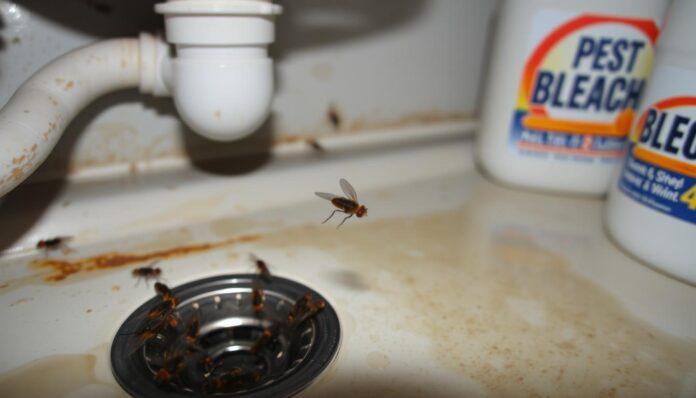Are you tired of dealing with drain flies in your home? These pests can be a real headache. But, there’s good news: you can get rid of them using bleach. But does bleach really work? Let’s find out how effective it is and what else you can do to solve the problem.
Key Takeaways
- Drain flies thrive in moist environments and can quickly escalate from a small problem to a full-blown infestation
- Bleach can kill drain flies and their larvae on contact, but its effectiveness is limited for long-term control
- Comprehensive pest control solutions often require a combination of cleaning, preventive measures, and professional assistance
- Caution is advised when using bleach, as it can generate toxic fumes and damage plumbing systems
- Natural alternatives like baking soda and vinegar provide a safer approach to eliminating drain flies
Understanding Drain Flies and Their Habits
Drain flies, also known as sewer flies or moth flies, are a common problem in homes. They are small, measuring 1 to 5 mm in length. They can quickly become a nuisance, especially in bathrooms and kitchens. Knowing how drain flies look, where they breed, and their life cycle is key to dealing with them.
Physical Characteristics of Drain Flies
Drain flies have light gray or tan bodies and hair-covered wings. They have six legs and antennae. Their small size, about 1.5 to 5 mm, makes them hard to tell apart from other tiny pests. The larvae, without legs or eyes, can grow up to 10 mm.
Common Breeding Locations
Drain flies love moist, rich environments. They are often found in drains, septic tanks, and places with lots of organic matter and sewage. Adult flies lay up to 100 eggs at a time in these damp spots. Their larvae feed on the available food.
Life Cycle and Reproduction
The drain fly life cycle is quick, from egg to adult in just one week. Females lay their eggs in moist, organic buildup in drains or pipes. The larvae hatch in 48 hours and feed on bacteria, fungi, and microbes. They then pupate and emerge as adult flies, starting the cycle again.
Knowing how drain flies look and behave is the first step to dealing with them. Whether in bathrooms, kitchens, or other damp spots, being proactive helps keep your home fly-free.
Identifying Signs of a Drain Fly Infestation
Small dark-colored insects flying around your kitchen or bathroom sinks might mean you have drain flies. These pests, also known as “sink flies” or “filter flies,” are common in homes. They show there’s a problem with your plumbing or drainage.
Drain flies are about 1.5 to 5 millimeters long. They look like fruit flies but prefer drains to fruit. When you crush them, they leave a powdery residue.
- Drain flies are weak fliers and are commonly found crawling on walls or indoor surfaces.
- A severe infestation may require professional pest control intervention to effectively eliminate the problem.
- Drain flies can carry bacteria from decaying matter, potentially contaminating food preparation areas.
Drain flies mean you have a slow or clogged drain. This is perfect for them to breed. Fixing the plumbing or drainage issue is key to getting rid of them.
| Characteristic | Description |
|---|---|
| Size | 1.5 to 5 millimeters in length |
| Larvae Length | Up to 9 millimeters |
| Larvae Color | White or cream-colored |
| Nymphs to Adulthood | 9 out of 10 nymphs grow to adulthood |
| Homeowners Affected | 25% of homeowners experience drain fly infestations |
Knowing the signs of drain fly infestations helps you act fast. This way, you can keep your home clean and free of pests.
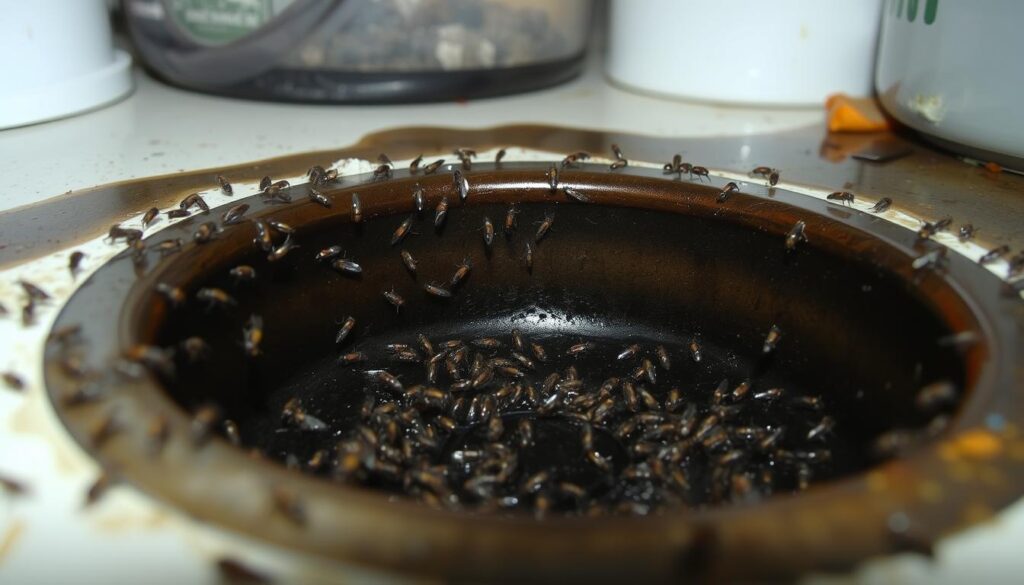
Why Drain Flies Appear in Your Home
Drain flies, also known as moth flies, can be a real nuisance at home. They love moist places, making drains a perfect spot to breed. Knowing why they show up helps you stop them before they spread.
Standing Water Issues
Drain flies are drawn to standing water. They lay eggs in slow drains, leaks, and any place water stays. Fixing plumbing issues is key to stopping their breeding.
Organic Matter Buildup
Drain flies eat organic stuff in drains like hair and food. This buildup is their food source. Cleaning drains regularly can stop them by removing their food.
Plumbing Problems
Drain flies also come from plumbing issues like clogs and leaks. These problems create the right conditions for them to grow. Fixing plumbing is crucial to get rid of them.
By tackling the reasons for drain fly problems, you can keep your home pest-free. Being proactive in solving these issues is the best way to control these pests.
Will Bleach Kill Drain Flies?
Bleach might seem like a good choice for getting rid of drain flies. But, it’s not always effective. Bleach can kill drain flies and their larvae when it touches them. However, it doesn’t last long because it gets diluted quickly in pipes and drains.
The female drain fly can lay up to 100 eggs at once. This means the problem can come back fast. Also, the buildup of eggs and larvae can block bleach from reaching the source of the issue.
Using bleach also has risks. Pouring it down drains can damage older pipes and septic systems. Mixing bleach with other household chemicals can create dangerous fumes.
In short, bleach might help for a little while, but it’s not a good long-term solution. Drain fly larvae are tough, and using bleach can be risky. It’s not the best way to get rid of these pests.
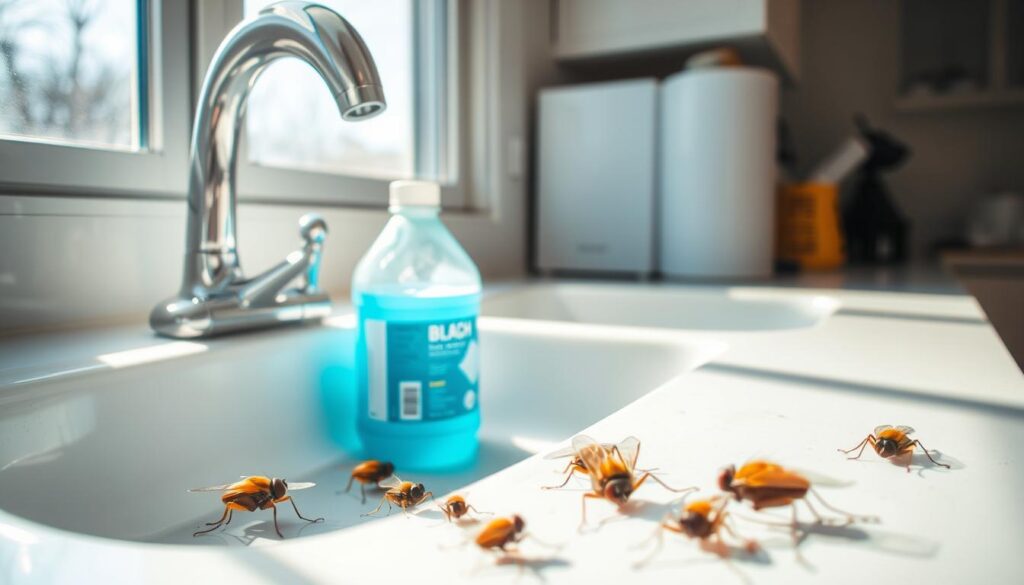
For a better and safer way to fight drain flies, try vinegar, baking soda, or special drain cleaners. These can help break the breeding cycle and get rid of the stuff that draws drain flies in the first place.
The Effectiveness of Bleach as a Drain Fly Treatment
Drain flies can be a big problem, but many people use bleach to fight them. Bleach can work well against these pests, but you need to use it carefully and correctly.
How Bleach Works Against Larvae
Bleach kills drain fly larvae and eggs right away. Its strong nature helps clean out drain pipes and get rid of some larvae. But, as bleach mixes with water in the pipes, it loses strength. This makes it harder to reach and kill larvae deep in the pipes.
Proper Bleach Application Methods
To get the best results, pour about one cup of bleach down the drain. Mix one part bleach with 10 parts water to kill drain flies. But, be careful not to use bleach in homes with septic systems. It can harm the bacteria and damage the system.
While bleach can help against drain flies, it’s important to be careful. Other methods, like vinegar and baking soda or boiling water, might be safer and more effective. If the problem doesn’t go away, it’s a good idea to call a professional exterminator.
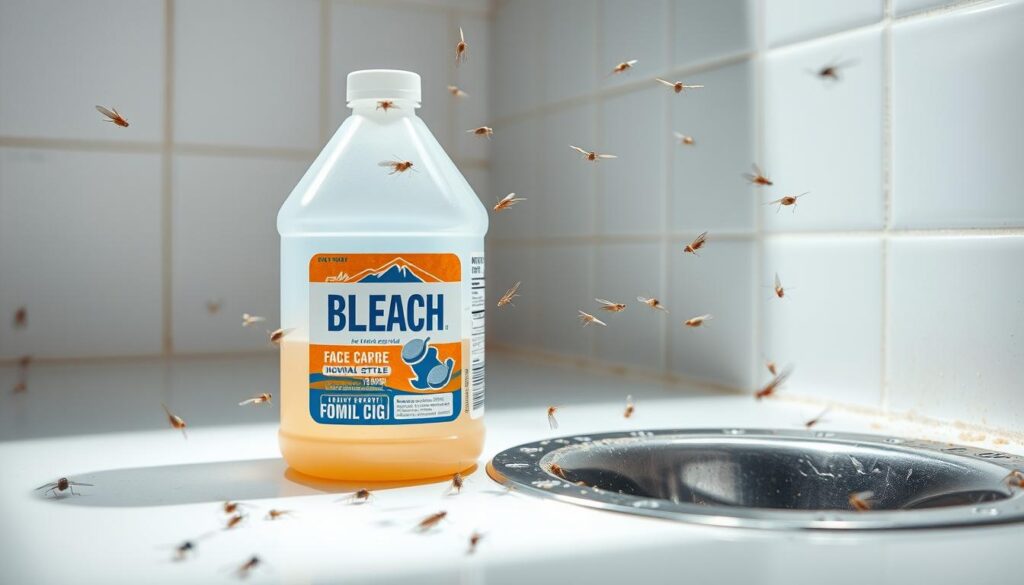
Risks and Limitations of Using Bleach
Bleach can kill drain flies, but it comes with risks. It can make toxic fumes when mixed with other things, which might hurt your breathing. It can also harm your septic system, damage pipes, and harm the environment.
Bleach moves fast through pipes, which means it doesn’t stay long enough to kill all the pests. It might kill the adult flies, but it won’t get rid of the eggs and larvae. Also, bleach can be too harsh for your plumbing and might not solve the problem for good.
- Bleach can create toxic fumes when mixed with other substances, potentially causing respiratory issues.
- Bleach may damage septic systems, corrode lead or plastic pipes, and harm the environment.
- Bleach’s quick flow through pipes limits its contact time with drain fly eggs and larvae, reducing its effectiveness.
- Bleach may not be a suitable long-term solution for recurring drain fly infestations due to its harsh effects on plumbing.
Because of these risks, safer options are often better for dealing with drain flies for good. You can try enzyme-based cleaners, baking soda and vinegar, or get help from pest control experts.
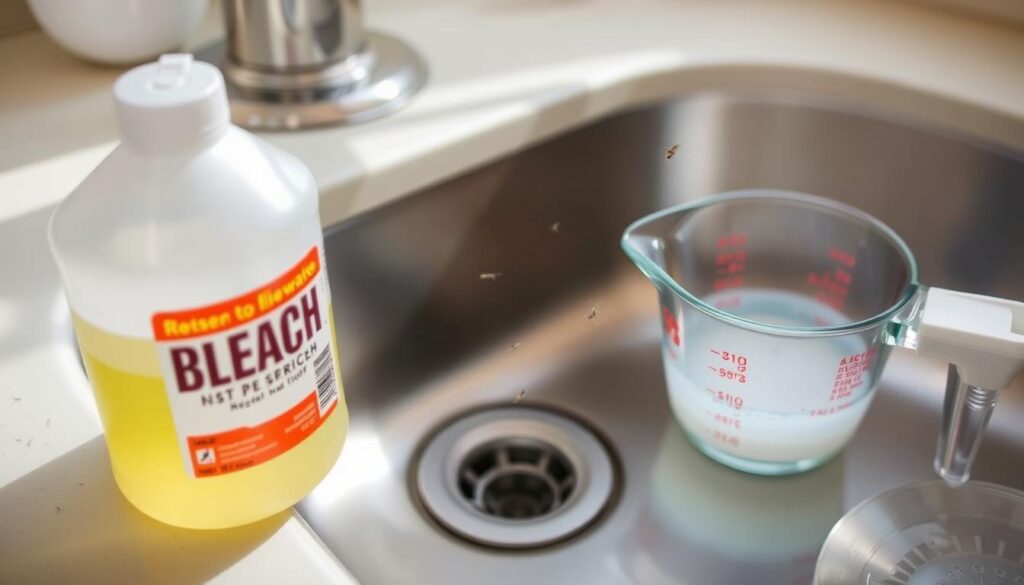
“While bleach can be an effective solution for eliminating drain flies, it’s important to understand the potential risks and limitations of this approach.”
Alternative Natural Solutions for Drain Fly Control
Dealing with drain flies can be tough, but there are natural ways to fight them. You can try vinegar and baking soda, or boiling water. These methods are kind to the environment and your pipes.
Vinegar and Baking Soda Method
The vinegar and baking soda mix is a simple yet strong solution. Mix equal parts of each, then pour it down the drain. The mix creates bubbles that help get rid of larvae and buildup. Let it sit for 30 minutes before rinsing with hot water.
Boiling Water Treatment
Boiling water is another great way to kill drain flies. Boil water, then pour it down the drain. The hot water will kill any flies or eggs. Do this a few times to make sure you get them all.
These natural methods are better for your pipes and the planet than harsh chemicals. They help solve the problem by getting rid of standing water and buildup. This way, you can keep your home free from natural drain fly remedies.
| Natural Drain Fly Remedy | How it Works | Effectiveness |
|---|---|---|
| Vinegar and Baking Soda | The chemical reaction dislodges and flushes out organic matter and larvae | Highly effective at eliminating drain flies and preventing future infestations |
| Boiling Water Treatment | The high temperature kills drain fly eggs, larvae, and adults | Effective for killing immediate drain fly populations, but may not address underlying issues |
Using these household drain cleaners lets you fight drain flies without harsh chemicals. Also, fix any plumbing issues to keep them away for good.
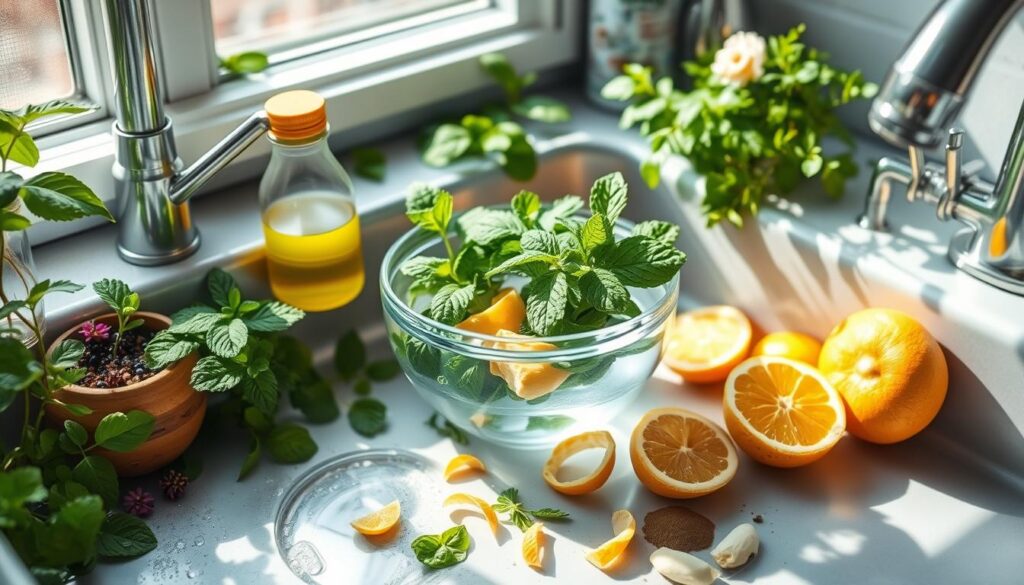
Preventing Future Drain Fly Infestations
To keep drain flies away, it’s important to stay proactive. Regularly clean your drains to get rid of organic buildup. Fix any leaks and make sure drains are used often to avoid standing water.
Using biological drain cleaners is a smart move. They break down organic matter without harming your pipes. Keeping drains and areas around them dry is also key. Addressing plumbing problems quickly helps prevent drain fly issues.
- Regularly clean your drains to remove organic buildup, the primary food source for drain fly larvae.
- Fix any leaks or plumbing issues that can lead to standing water, as this creates an ideal breeding ground for drain flies.
- Ensure all drains are used frequently to prevent the accumulation of stagnant water.
- Use biological drain cleaners that effectively break down organic matter without damaging your pipes.
- Keep drains and the surrounding areas as dry as possible to make the environment less hospitable for drain flies.
By taking these steps, you can stop drain fly infestations before they start. Keeping your home clean and watching for pests is crucial. This way, you can enjoy a pest-free home for a long time.
| Prevention Measure | Effectiveness | Ease of Implementation |
|---|---|---|
| Regular drain cleaning | High | Moderate |
| Fixing plumbing leaks | High | Moderate |
| Using biological drain cleaners | High | Easy |
| Ensuring frequent drain use | Moderate | Easy |
| Keeping drains and areas dry | High | Easy |
By following these steps, you can stop drain flies and their larvae from taking over. This keeps your home clean and free from pests.
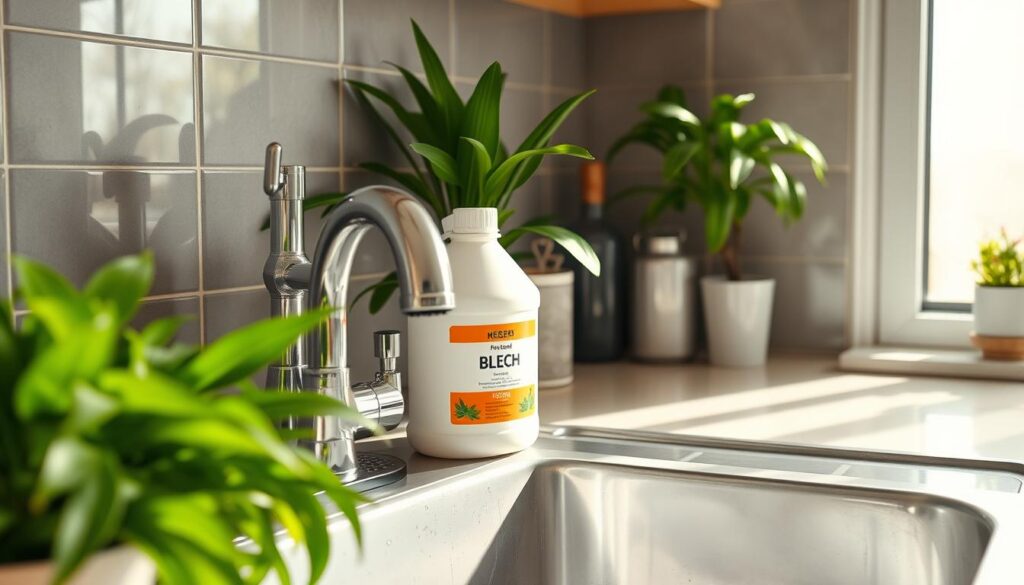
“The best way to deal with drain flies is to prevent them from ever getting a foothold in the first place.”
When to Call Professional Help
Home remedies can help with minor drain fly problems. But, sometimes, you need professional pest control. If your problem doesn’t go away, or if you see a lot of flies, call an exterminator.
Signs of Severe Infestation
Some signs mean you need more than DIY solutions. Seeing lots of flies, having the same problem over and over, or finding flies in many drains are red flags. If your problem gets worse or spreads, it’s time for a pro.
Professional Treatment Options
Pest control experts have special tools and methods. They might use insect growth regulators or treatments for larvae and adults. They can also find and fix plumbing issues that cause the problem. With their help, you can solve a tough drain fly problem.
